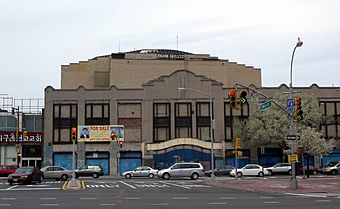RKO Keith's Theater (Flushing, Queens) facts for kids
|
RKO Keith's Theater
|
|

RKO Keith Flushing, April 2009
|
|
| Location | 135-35 Northern Blvd., Flushing, New York |
|---|---|
| Area | less than one acre |
| Built | 1928 |
| Architect | Thomas Lamb |
| Architectural style | Mission/Spanish Revival |
| NRHP reference No. | 82001260 |
Quick facts for kids Significant dates |
|
| Added to NRHP | October 29, 1982 |
The RKO Keith's Theater is a historic movie theater in Flushing, Queens, New York City. It was designed by architect Thomas W. Lamb and built in 1928. The outside of the building looks simple. However, the inside of the theater was designed in a beautiful Spanish Baroque Revival style. The theater could seat about 2,974 people.
Contents
History of the RKO Keith's Theater
The RKO Keith's Theater opened on Christmas Day in 1928. It was a place for both "vaudeville" shows and movies. Vaudeville was a popular type of entertainment with many different acts. In the 1970s, the theater was updated to have three movie screens.
Famous Performers and Changes
Many famous stars performed at this theater. These included Bob Hope, Jack Benny, and the Marx Brothers. Other big names like Judy Garland, Mae West, Milton Berle, Jimmy Durante, and Jerry Lewis also entertained audiences on stage. On January 16, 1965, Hollywood stars Cesar Romero and Connie Stevens also performed there. Connie Stevens lived nearby in Bayside at that time.
The theater closed in 1986. A new owner, Thomas Huang, bought it for $3.4 million. He wanted to turn it into offices or a shopping mall. However, he damaged parts of the building without permission. This caused his building permits to become invalid. Community leaders were upset because they wanted to protect the theater as a landmark.
Challenges and New Plans
During his ownership, Mr. Huang also improperly put about 10,000 gallons of waste materials in the theater's basement. He faced serious legal problems and admitted to breaking rules. He was ordered to fix the problems at the theater. However, he did not follow this order.
The theater was sold several times after that, in 2004, 2010, and 2013. It stayed empty since it closed in 1986. In 2016, a company called Xinyuan Real Estate bought the building. They announced plans to build a 16-story luxury apartment building. The new building will keep the original front of the theater. The famous architect I.M. Pei's firm designed the new building. Demolition of the old theater began in November 2019. The beautiful plasterwork from the lobby was carefully removed. It was cut into numbered sections and stored. The plan is to put these pieces into the new building.
Saving the Theater
The RKO Keith's Theater was added to the National Register of Historic Places in 1982. This means it is a special place worth protecting. In 1984, the theater's ticket lobby and grand foyer were named landmarks by the New York City Landmarks Preservation Commission.
Efforts to Protect the Landmark
A group called the "Committee to Save the RKO Keith's Theatre of Flushing, Inc." started working in 1981. They wanted to keep the theater and use it again as a performing arts center. In 1986-87, over 3,000 people from Queens signed petitions. They asked New York City to make the entire theater a landmark.
Jerry Rotondi, a co-founder of the Committee, shared stories from people. One man proposed to his wife in the theater's balcony. Another person said his father used to provide goldfish for the fountain in the main lobby. These stories showed how much the theater meant to the community. When people learned that the theater was bought by a developer who wanted to build a hotel, the Committee grew. They gained support from groups like the Theater Historical Society and the New York Landmarks Conservancy.
In early 1989, parts of the RKO Keith's interior were damaged. Two sets of bronze doors were stolen. Jerry Rotondi asked for an inspection from the Landmarks Preservation Commission. After checking the damage, a new gate was built to protect the landmarked area.
In 2009, people who wanted to save the theater tried to buy it. They hoped to use it again as a performing arts center. The theater was valued at $24 million. These "Friends of RKO Keith's" hoped to get donations from famous actors. They even hoped Jon Favreau would donate because he once worked there selling popcorn.
Images for kids





